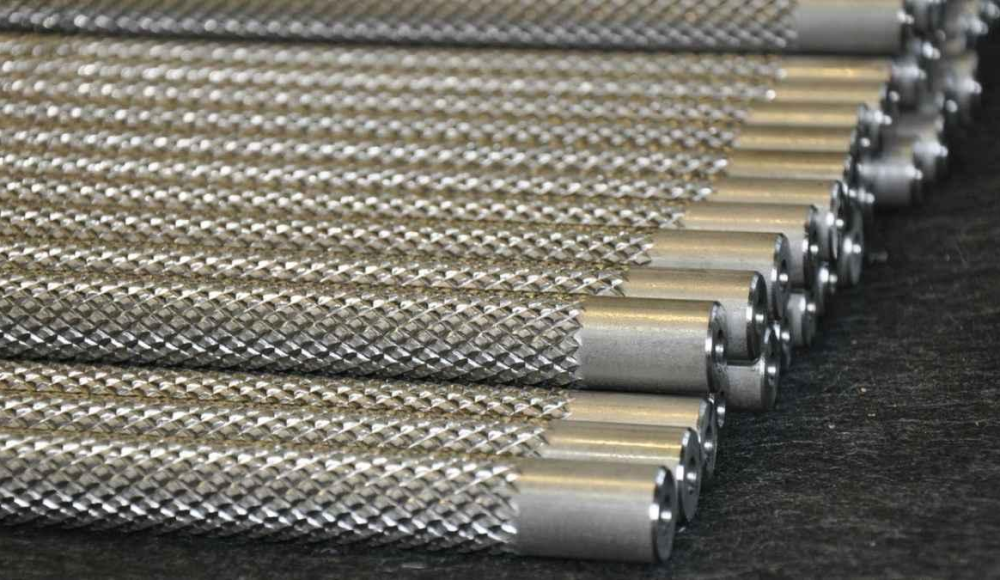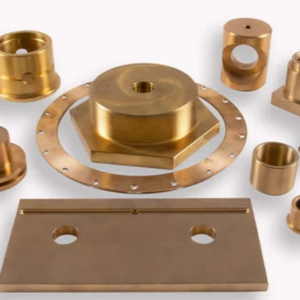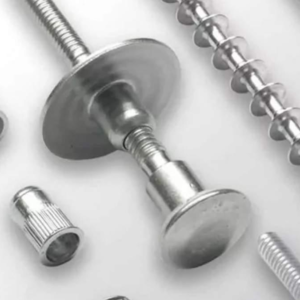Machining industries apply different finishing processes on machined parts. One of them is known as knurling which is used to bring about textured finishes. The contour lines generated are unique as they form crests and troughs on the parts created.
This article also defines knurling, types of knurling, and usual imperfections. In addition, knurling techniques, required tools, and helpful guidelines for optimal knurling will be discussed.
What is Knurling In Manufacturing?
Knurling is a surface finishing operation that creates raised patterns or cut-out ridges on mating surfaces. This technique is well applicable when using lathes or hand tools. Textured finishes make the surface rough to reduce slippage while in use. Moreover, knurling looks better than other smooth types of finishes with grooves and ridges. This process works as a cutting or pressing method of material removal machining. Knurling tools feature various patterns, including diagonal and straight lines.
Types of Knurling Techniques In Manufacturing
Different knurling techniques are used to produce particular surface textures on the pieces of work.
1. Straight Knurling
Straight knurling produces longitudinal depressions on surfaces utilizing heavily worn wheels, and they produce parallel or diagonal lines. The method helps to make a better grip and handling in different sectors. Benefits of straight knurling include:
- Aesthetic Enhancement: Straight knurls contribute to the product’s design, improving attractiveness. These patterns are suitable for tubular products like handles or knobs in this case. Moreover, they are applied to luxury goods, for example writing instruments or jewelry.
- Firm Grip Functionality: Straight knurling forms rough profiles, which make handling easier. These patterns create a rough surface that makes contact of hands with objects to be handled more secure therefore minimizing chances of slippage.
2. Diamond Knurling
Diamond knurling is viable for producing a series of diamond-shaped roughness on the workpiece surface. The technique has crossed diagonal lines, which create two different diamond patterns. Achieving such finishing requires wheels with diamond-patterned knurls. Unique attributes of diamond knurling include.
- Decorative Application: The shallow diamond-shaped depressions are also more aesthetically appealing. The second type of knurling is used in the production of elements such as bicycle parts, thin casings, or personal belongings. The outcome of this is that the appearance of the set is both beautiful and highly advanced.
- Improved Grip: Circumferential diamond knurling enhances grip on hand-held workpieces to a greater extent. There is a great number of contact points that exist between the hand and the surface, this improves the traction. As a result, this finish can be easily manipulated by objects.
3. Helical Knurling
The helical knurling forms diagonal lines in a spiral fashion on surfaces. Generally, it is done on cylindrical parts as is the case with screw threads. Typical uses and benefits include:
- Decorative Purposes: Helical knurling is specifically employed for aesthetic purposes. The technique is well-suited for conjunction with plating and polishing to achieve enhanced product aesthetics.
- Enhanced Functionality: Most round objects like knobs, shafts, and handles benefit from helical knurling as an enhancement technique. Its design enables it to have a firm grip when in operation and during rotation.
- Thread Formation: This technique applies to cylindrical products and makes threads for them. It meets specific requirements effectively. This minimizes additional threading processes which are usually time-consuming. As such, the process is effective and economical.
Types of Knurling tools for Knurled finish
Tools are usually selected depending on particular demands. Some typical tools used in metal knurling include:
1. Knurling Wheels
Knurling wheels are crucial for metal knurling. They are typically made of hardened steel with sharp teeth and rotate in adverse directions. The wheels are mounted on a knurling tool, and pressure is applied to the rotating workpiece.
2. Knurling Inserts
Knurling inserts are accessories usually used in lathes. Every insert has a different knurl pattern depending on the finish type used. It is available in different sizes and shapes. Generally, inserts are manufactured of metal carbide and high-speed steel.
3. Knurling Dies
Knurling dies are used in turret lathes and CNC processes. The latter two types of dies are used to produce knurled patterns on a cylindrical surface. Cutting tools of high-speed steel are provided with grooves that fit into the internal profile of the workpiece.
4. Push-Type Knurling Tools
Push-type knurling tools are hand-operated instruments for making patterns. These tools usually have a knurling wheel connected to a handle. It advances along the workpiece to give the necessitated knurling surface texture.
5. Floating Knurling Tools
Some tools are floating knurling tools which create patterns on complex geometry. Intended to run along the contour of the workpiece, they secure efficient and precise knurling. Accuracy in positioning of the wheels is done through articulated arms or spring-loaded mechanisms.
Challenges Encountered In Knurled Machining Components
Grip components are used for aesthetic and practical applications in professions such as jewelry, furniture making, automotive, and aviation. However, product manufacturers normally encounter several challenges while knurling.
1. Under or Over Size
The desired diameters of the knurling patterns are as important to manufacturers as any other product specifications. Mis-sizes can occur when the knurling pattern is smaller than intended. Oversizing happens when the pattern developed goes beyond the required size. In addition, wrong first settings, wrong tool selection, and high working pressures may often result in oversizing.
2. Surface Damage
During knurls fabrication, some materials usually get gouged. This harm often arises when using high pressure on the tools or when using old knurling tools hence developing some kind of distortion on the work piece.
3. Tool Wear
The knurling tools are non-uniform. So, tools may wear out over time. Flaws such as flattened areas and burrs are evidence of the impact of tool wear on the performance of a tool which results in a decline in efficiency. Such problems are compounded by its constant utilization thus affecting the quality.
4. Poor Pattern Definition
For high-quality knurling, patterns must be clear, concise, and well-defined. Because, Inadequate lubrication, wrong tool choice, or damaged knurling wheels may lead to blurred finishing.
5. Chattering or Vibration Marks
Chatters and vibration marks are signs that usually look like random markings on material surfaces experienced in the process of knurling. These happen due to wrong pressure on the tools, insufficient stiffness, and mispositioning during the setting up of the knurling machine.
Tips For Effective Knurling In Manufacturing
Let’s discuss some general tips for obtaining the right knurled finish in components:
1. Proper Workpiece Preparation
When etching, it’s essential to prepare the workpiece very well to achieve optimum results. Because any slight imperfection or inclusion can cause poor knurling to be produced. Furthermore, cleaning and securing the workpiece to an accurate dimension helps avoid under or over-knurling dimensions before the operation starts.
2. Selecting the Right Knurling Tool
Knurling tools can be classified according to the teeth’ shapes, the pitch, or the design used. For successful material processing, it is necessary to select the tool that will be suitable in terms of the hardness and roughness of the treated material.
3. Applying Lubrication
The kind of cutting fluids or lubricants to use while engaging in knurling has to be observed. Correct lubrication reduces heat and friction and improves the surface roughness of the knurled finish depending on the material being worked upon.
4. Control of Optimal Cutting Speed
To minimize tool wear and ensure proper chip formation, it’s crucial to establish the correct cutting speed. Identify the appropriate lathe speed based on the metal type used for knurling. Therefore, following the manufacturer’s guidelines for specific materials is essential.
5. Proper Tool Surface Pressure
Higher pressure can negatively impact the workpiece. Besides, a little pressure can result in shallow patterns on the intended part. Pressure control is vital during knurling and must align with the material and tool type.
Conclusion
To sum up, the information in the article enables you to distinguish different types of knurling tools, patterns, and some general problems in operations. This knowledge helps you make better choices for your projects on your own. However, collaborating with a reliable manufacturing company can lead to profitable outcomes. When it comes to knurling, Tops Precision is amongst the best to turn to. If you require knurled finishes or any further post-finishing services, Tops Precision is the perfect solution.



